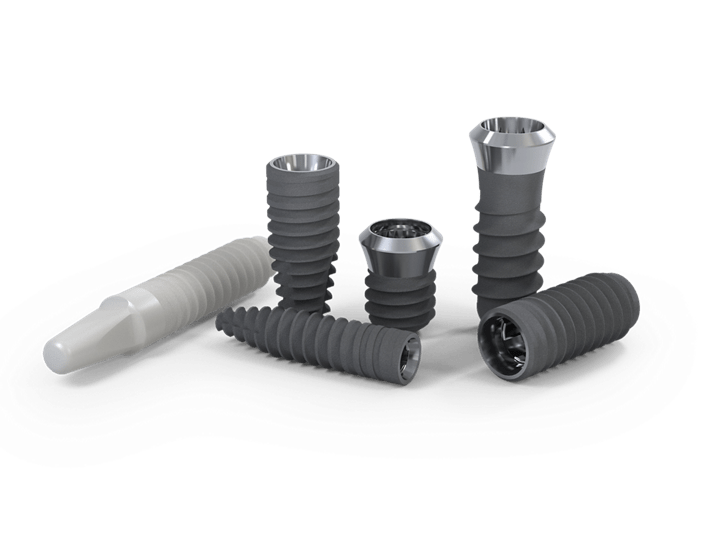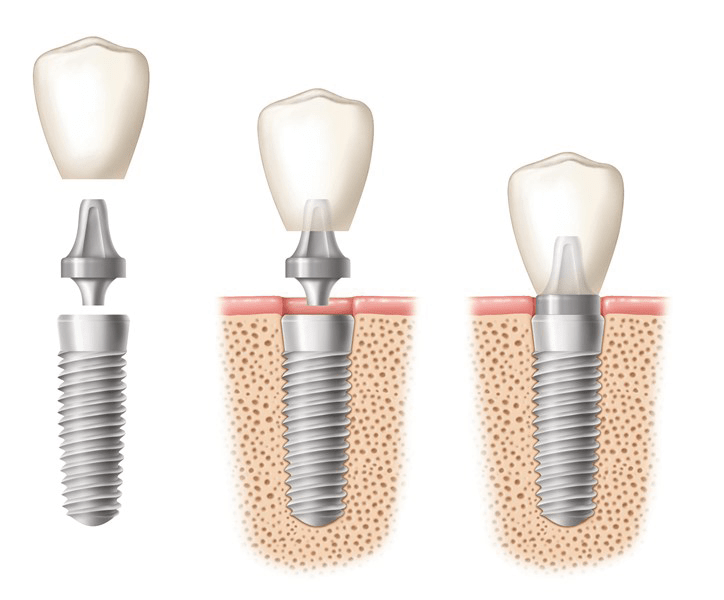What is a dental implant?
A dental implant is an artificial root of the teeth that is screwed into the jaw bone to replace a tooth.
Once mounted, the implants are covered by a dental crown, giving a natural look.
They offer a long-term solution for those who have one or more missing teeth.
Dental implants provide an excellent way to restore oral health and stability. If you have missing teeth, this dental procedure can allow you to smile again with confidence.
How do dental implants work? Are they right for you? How long does a dental implant procedure take? Are there any risks? And how much does it cost? These are important questions to consider when planning to opt for dental implants.


An implant consists of three parts:
1. Implant screw: a titanium or ceramic pillar that is screwed into the jaw bone to serve as a replacement for the natural root of the teeth.
2. Abutment: body that serves as a connector between the implant and the crown.
3. Dental crown: an artificial tooth placed above the implant device to give it a natural look.
An implant consists of three parts:
1. Implant screw: a titanium or ceramic pillar that is screwed into the jaw bone to serve as a replacement for the natural root of the teeth.
2. Abutment: body that serves as a connector between the implant and the crown.
3. Dental crown: an artificial tooth placed above the implant device to give it a natural look.

When should I have a dental implant?
The dental implant is the right solution for you. if:
- You have missing or damaged teeth.
- You cannot wear dentures.
- Look for a long-term solution.
While you are planning your dental implant procedure, there are a few things that your dentist should do. will look.
- Bone density in the jaw. If you have a low bone level, then it may be necessary to add bone before you can insert the implants.
- Any signs or symptoms of advanced gingival disease. These should be treated before dental implants are inserted.
- Any serious caries should be removed before your dental implants are inserted.
- If you are taking steroids, receiving chemotherapy, or radiation treatments, you may not be eligible for dental implants because of the increased risk of infection and other possible complications, such as osteonecrosis.
Dental implantation procedure: step by step
Each stage of the dental implant is different because the complexity of the treatment can vary from patient to patient. But, there are common steps you can expect at the time of treatment.
Pre-operational planning
To determine the best treatment plan for your needs, your dentist will need an updated x-ray of your mouth. This will allow them to assess the health of the teeth and determine if it will be necessary to remove the teeth, add bone or lift the sinuses to mount dental implants. During the first consultation, the dentist may also schedule additional examinations or request a CT scan to check the bone mass.
Bone addition
If the dentist finds that you do not have enough natural bone in the area of the planned implant, he may recommend bone addition. But what is it ? The procedure involves placing a natural or synthetic bone material in an area where there is not enough bone. Depending on the amount of bone mass required, a graft can be performed at the same time as the surgery of the implant or in a separate session.
When only a minor bone graft is needed, it is possible to perform the procedure at the same time as the implant surgery. But if a more significant bone addition is needed, then it could take several months for the graft to create new, strong bone.
Implant insertion
This step may vary, depending on how many dental implants you need and the complexity of your situation. Usually surgery can take less than an hour to six hours. The procedure takes place under local anesthesia and is the same no matter how many implants are mounted.
The gingival tissue is opened to expose the bone area where the implant will be placed. Once the jaw bone is exposed, the dentist will use a special drill to create the space for the dental implant. The implant is then placed in the jaw bone and the gums are closed. Your surgeon will place a temporary crown, prosthesis or fastener to fill the hole created.
Healing and recovery phase
Once the first part is complete, the next step is to allow the screw implant to become part of the jaw. This process is known as osseointegration and usually takes about 3-6 months in total.
Attachment of the abutment and the crown
When the gingival tissue is completely healed, it is re-exposed to attach the abutment to the implant. The dentist will make impressions of the mouth to create a crown in a dental laboratory that will be similar and fit perfectly with existing teeth. This process can take 3 to 10 days. Once the crown is ready, it is placed above the abutment, mimicking the natural appearance of the tooth.
Post-operative care
It is common to experience some bruising and swelling after inserting a dental implant. This is usually a short-term side effect, and the long-term success of your new implant depends on maintaining good oral hygiene. Make sure you have a good brushing technique, both for your implant and the surrounding gingival tissue. Regular checkups with your dentist – every 6-12 months – are also key to a long-term implant.
What to expect after treatment: post-implantation recovery
The installation of dental implants does not generally lead to a difficult recovery period, with most patients returning to work the next day. But, after you have done the first part of the treatment – implant insertion – it is normal to experience:
- Some pain around the implant
- Some minor bruising and swelling of the face
- Minor bleeding gums
They should start to lighten up after about a week. You will have to wait about 3-6 months before mounting the abutment and the crown. This allows the implant to become part of the jaw and gives the gingival tissue time to heal.
Risks and benefits of dental implants
Before undergoing your dental implant procedure, it is important to be aware of both the benefits that treatment can bring and the risks associated with it.
The advantages of dental implants
About 98% of dental implant procedures are considered successful. The treatment offers a long-term solution for those who want to replace lost teeth. There are several key benefits to this treatment.
- Increased comfort and confidence as you smile, eat and talk.
- A stable and long-lasting solution, unlike other temporary dental treatments, such as dentures. With good dental hygiene, the implant itself usually lasts a lifetime, while crowns should only be replaced after about 5-20 years.
- A healthier jaw due to growth stimulation caused by osseointegration.
Risks of dental implants
While dental implants can bring great benefits, there are some risks associated with them. The main ones include:
- Implant site infection.
- Injuries or damage to surrounding structures (teeth or blood vessels).
- Damage to the nerves during implant placement, causing pain or numbness.
It is worth noting that health complications caused by dental implants are rare and most can be resolved with minor interventions.
Can I replace all my teeth with dental implants?
For those who want to restore more lost or damaged teeth, there are two treatment options – All-on-4 and All-on-6 dental implants. These methods may be recommended if you have a significant loss of teeth or if you have a low bone density in the jaw area that prevents you from opting for individual dental implants.
What are All-On-4 dental implants?
The all-on-4 dental implant method involves a complete rehabilitation of the arch in which all teeth are supported by four implants. These implants – which must support 10-14 custom crowns – are placed in either the upper or lower dental arch.
What are All-On-6 dental implants?
For patients who have a larger number of missing teeth, the All-on-6 technique may also be a viable option. This works similarly to All-on-4, but involves the placement of six implants.
How much does a dental implant cost?
The cost of dental implants depends on a variety of different factors.
Dental implant prices may change depending on:
- The material used to make the crowns
- The number of teeth that are being replaced
- Position of damaged or missing teeth
- If bone addition is required
- The dentist and clinic you choose
- Choosing premium dental implants
Price in Romania: 400 EUR – 2000 EUR – premium implant
Why choose ROMEDAS?
The objective of ROMEDAS is to it helps everyone to access high quality medical treatments in Romania , to prices PREFERENTIAL . Putting patients first, we work hard to cancel the one-size-fits-all approach that occurs so often in the healthcare industry.
✔ 100% free evaluation, non-binding: We offer a 100% free, non-binding evaluation for each patient, whether or not they continue to book a treatment.
✔ Top dentists, check: Our verification system, ROMEDAS, evaluates dentists on more than 10 data points, including things like their qualifications, experience, accreditations and reviews from past patients.
✔ Preferential rates and price matching: we have made every effort to identify exceptional dentists in Romania who offer the best treatment at the right price. Did you find the same treatment, at the same clinic, cheaper elsewhere? We will match the price!
We guarantee preferential rates in our partner clinics.
Disclaimer
The information in this article is for educational purposes only and does not replace medical advice. Always consult your doctor before starting any treatment.
